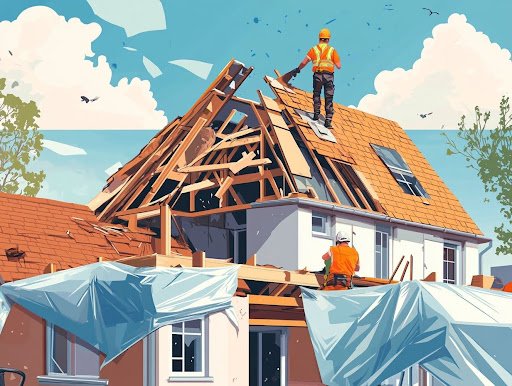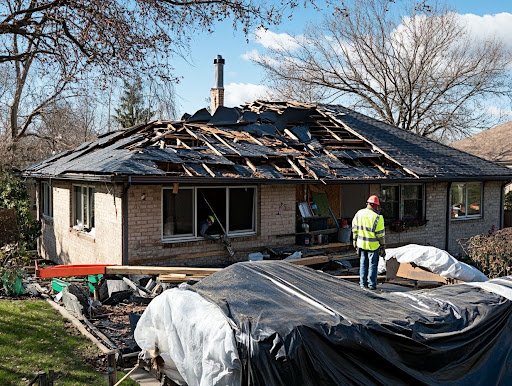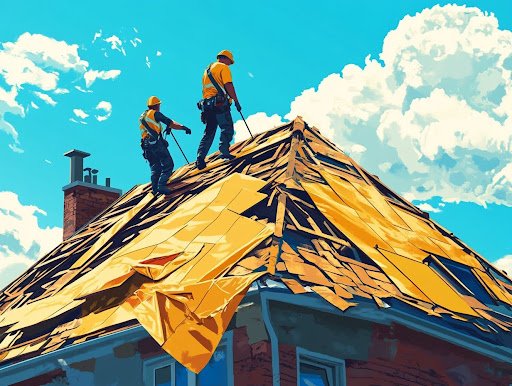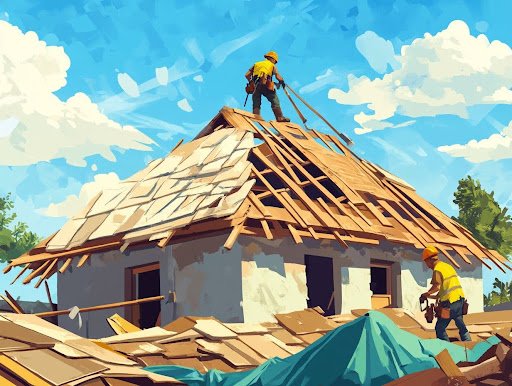Roof Replacement Process Brisbane (Step-by-Step)
- Trusted Roofing Professionals Brisbane
- Free Quotes Available
- Contact Us Now
Roof replacement is an essential home maintenance task that can significantly improve a property’s safety, aesthetics, and overall value. Whether the roof is exhibiting signs of aging, experiencing damage from severe weather, or deteriorating due to regular wear and tear, recognising the need for replacement is crucial. This guide provides a comprehensive overview of the step-by-step process of roof replacement in Brisbane, outlines what to expect during the project, and offers recommendations for selecting a qualified contractor to ensure a smooth and efficient experience.
Key Takeaways:
- Regular roof inspections are essential to assess the need for replacement due to age, weather damage, and wear and tear.
- The step-by-step process of roof replacement in Brisbane includes inspection, obtaining permits, material selection, removal, repair and installation.
- During the process, expect noise, potential delays, and safety precautions. Choosing a reputable, experienced contractor with proper licenses, insurance, and warranties is vital.
Why is Roof Replacement Necessary?
Roof replacement is essential for homeowners in Brisbane and surrounding areas who seek professional assistance. It plays a vital role in maintaining the safety and integrity of their residences, particularly in light of the region’s unpredictable weather conditions and the potential damage that may occur over time.
Like any other structural component, roofs possess a finite lifespan that can be considerably influenced by age, extreme weather conditions, and regular wear and tear.
Recognising the importance of roof replacement enables homeowners to make informed decisions regarding repairs or restoration processes, ensuring their homes remain protected and aesthetically appealing.

Age of the Roof
The age of a roof is a critical factor in determining the necessity for a replacement, especially when considering roofing systems. Most roofing materials possess a finite lifespan that can vary significantly depending on the type used.
A comprehensive understanding of the lifespan of various roofing materials enables homeowners to make informed decisions regarding maintenance and repairs. For example, asphalt shingles generally have a lifespan of approximately 20 to 30 years, while metal roofs can last between 40 and 70 years, demonstrating substantial durability under varying weather conditions.
However, age alone does not dictate the need for replacement; climate, installation quality, and maintenance practices also significantly influence this determination. As they age, roofs become increasingly vulnerable to leaks and damage, underscoring the importance of regular inspections and timely repairs.
- Asphalt Shingles: 20-30 years
- Metal Roofs: 40-70 years
- Tile Roofs: Up to 100 years
- Wooden Shakes: 30-40 years, requiring regular maintenance
In conclusion, monitoring the roof’s condition is essential for extending its lifespan and preserving structural integrity.
Damage from Extreme Weather Conditions
Extreme weather conditions, frequently observed in Brisbane, can significantly damage roofs, requiring timely interventions. Therefore, homeowners must identify the signs of wear and take appropriate measures.
Prolonged heavy rainfall can exceed a roof’s capacity to shed water, resulting in pooling and subsequent leaks. Hail can create dents and punctures that compromise the integrity of roofing materials, while strong winds can dislodge tiles from their secure positions.
Such weather events cause immediate concerns, but if not addressed on time, they can lead to long-term problems, including mould growth and structural damage. Therefore, property owners should prioritise regular inspections and seek professional roofing repair services to mitigate these risks.
Neglecting the early signs of roof damage can lead to expensive repairs and may pose significant risks to the home and its occupants.
Wear and Tear from Regular Use
Regular exposure to environmental elements can result in significant wear and tear on roofs, making timely maintenance and repairs imperative to prevent costly replacements.
Over time, the persistent effects of sunlight, rainfall, and falling debris can substantially deteriorate roof materials, necessitating regular roof cleaning. This continuous exposure may lead to cracked tiles, faded coatings, and blocked gutters, which increase the risk of leaks and potential structural damage.
Homeowners are encouraged to proactively protect their investments by conducting regular roof inspections, ideally at least twice a year. Particular attention should be given to the following aspects:
- Assessing for loose or damaged tiles
- Examining flashings and seals for integrity
- Clearing gutters and downpipes to ensure proper drainage
Establishing a comprehensive roof cleaning and maintenance schedule is essential for extending the roof’s lifespan, preserving the home’s overall value, and ensuring the safety of its occupants.
Step-by-Step Process of Roof Replacement in Brisbane
A comprehensive understanding of the step-by-step process of roof replacement in Brisbane is essential for homeowners seeking to engage qualified roofing companies and ensure the successful execution of their projects from initiation to completion.
This systematic approach encompasses critical phases, including:
- Inspections to evaluate the current condition of the roof,
- The selection of appropriate materials that consider local weather conditions and aesthetic preferences,
- The procurement of necessary permits, and
- The installation of the new roof.
Each phase necessitates careful planning and meticulous attention to detail to ensure long-lasting satisfaction and safety for homeowners.
Inspection and Assessment
The initial and critical step in the roof replacement involves a comprehensive inspection and assessment with expert attention to identify any existing damage and determine the most appropriate course of action for Brisbane homeowners.
During this meticulous evaluation, professionals carefully examine various critical factors that could influence the longevity and effectiveness of the new roof. They specifically look for signs of leaks, which may present as water stains or mould within the home’s interior. A careful examination of the following elements is essential to ensure proper water drainage:
- Flashing around chimneys and vents
- Roof tiles for signs of wear or curling
- Gutters for any blockage or damage
Additionally, structural concerns, such as sagging areas or missing support beams, must be identified, as these can indicate more significant underlying issues that require immediate intervention. This thorough inspection not only enhances homeowners’ understanding of the current condition of their roof but also plays a pivotal role in planning a successful roof replacement that adheres to both safety and aesthetic standards.

Obtaining Necessary Permits
Obtaining the necessary permits for roof replacement is a critical step that ensures compliance with Brisbane’s local regulations and building codes.
In the dynamic city of Brisbane, where strict adherence to construction standards is required, homeowners must navigate specific requirements when planning to replace their roofs. Various permits, such as the Building Permit, may be applicable, confirming that the proposed work meets safety and structural integrity standards. A Development Approval may also be necessary in situations involving significant alterations or if the residence is in a conservation area.
- It is essential to consult the local council for guidance on the required permits.
- Applications can typically be submitted online through Brisbane City Council’s official website, facilitating the process.
- Homeowners must provide relevant documentation, including plans and specifications of the intended work.
Failing to secure these permits can result in significant consequences, including substantial fines or the enforced removal of non-compliant structures, underscoring the importance of this step in the renovation process.
Material Selection
Selecting appropriate materials for roof replacement is critical for homeowners in Brisbane, as it affects both the aesthetic appeal and functionality of the roof. Each decision made concerning roofing materials can have a substantial impact not only on the property’s kerb appeal but also on its durability and performance under diverse weather conditions.
When evaluating roofing materials, it is essential to consider several options, each possessing distinct characteristics:
- Tiles: Tiles are widely preferred due to their cost-effectiveness and variety, although they may necessitate more maintenance and have a shorter lifespan than other alternatives.
- Metal: Recognised for its durability and resistance to extreme weather, metal roofing is frequently preferred in Brisbane, despite the higher initial investment required.
- Concrete: Although heavier and potentially more costly to install, concrete tiles provide outstanding insulation and longevity, making them well-suited for the local climate.
Factors such as cost, ease of installation, and suitability for the climate should be integral to the decision-making process.
Removal of Old Roofing Materials
Removing old roofing materials constitutes a critical phase in the roof replacement process, necessitating appropriate equipment, such as safety equipment and roofing nails, and safety measures to manage debris effectively.
During this essential stage, contractors and homeowners must employ safe techniques and follow safety tips to ensure the project proceeds smoothly and without hazards. The primary methods for removing old roofing typically involve using hand tools such as shovels and pry bars and power tools like roofing nailers. Proper material disposal is crucial to prevent environmental damage, and adherence to local regulations regarding waste disposal is mandatory.
Equipping oneself with the proper safety gear is essential. Workers should be equipped with:
- Hard hats to protect against falling debris
- Safety goggles to shield the eyes from dust and particles
- Heavy-duty gloves for hand protection
- Steel-toed boots to prevent injuries from punctures
Adhering to these guidelines can minimise the risk of accidents, thereby ensuring a safer and more efficient roofing project.
Repairing and Preparing the Roof Deck
Once the old materials have been removed, the subsequent step involves repairing and preparing the roof deck to establish a solid foundation for the new roofing installation, a crucial step in roof repairs.
This critical phase of the roofing process prevents future complications and enhances the home’s overall structural integrity. Conducting a thorough roof deck inspection enables homeowners to identify any pre-existing issues, such as water damage, rot, or weakened areas that could jeopardise the new roofing layers. Timely resolution of these issues is essential, as neglecting them may result in significant expenses in the future.
Proper preparation guarantees the surface is level and secure, providing optimal support for the new roofing materials. The following considerations are essential:
- Inspect for signs of moisture or mould, which can compromise the roof’s durability.
- Replace any damaged or rotting wood to prevent further deterioration.
- Ensure the roof deck is clean and debris-free to facilitate better adhesion.
- Verify that the deck is structurally sound to support the weight of the new roofing system.
By dedicating time and effort to this preparation phase, homeowners can have confidence that their roof is constructed on a strong and reliable foundation.
Installation of New Roofing Materials
Installing new roofing materials represents a critical stage in the roof replacement process, necessitating the expertise of skilled professionals like those from Brisbane Roofing Solutions to ensure that proper techniques and safety standards are maintained.
This essential phase safeguards the structural integrity and enhances the building’s aesthetic appeal and energy efficiency, adding visual interest.
Homeowners must verify that the roofing contractors they engage possess the requisite experience, as it significantly affects the roof’s longevity.
- Quality materials must be procured from reputable suppliers to mitigate the risk of future issues such as leaks or damage resulting from severe weather conditions.
- A thorough assessment of the existing roof structure before installation is crucial; any underlying damage must be addressed to avoid complications in the future.
- Compliance with safety protocols is essential to protect both the workers and those in proximity during the installation process.
By prioritising these considerations, the likelihood of a successful and enduring roof installation is substantially enhanced, thereby ensuring peace of mind for the property owner.

Finishing Touches
The finishing touches on a roof replacement project in Brisbane are essential for the new roof’s functionality and aesthetics.
To ensure a successful completion, several critical steps must be meticulously addressed:
- The installation of gutters is paramount. Gutter systems effectively direct rainwater away from the roof and foundation, preventing water damage.
- Following this, a thorough inspection for leaks is necessary. Any potential breaches must be sealed to guarantee the roof’s longevity and performance.
- Finally, aesthetic adjustments, such as ensuring all tiles are aligned and colour-matched, contribute to kerb appeal and enhance the property’s overall appearance.
By carefully managing these concluding tasks, property owners not only maximise the durability of their investment but also achieve a visually appealing outcome that complements the architecture of their home.
What to Expect During the Roof Replacement Process
For homeowners in Brisbane, a clear understanding of the roof replacement process is essential. This knowledge facilitates adequate preparation for potential disruptions while ensuring safety and satisfaction throughout the project.
Noise and Disruption
One of the most significant aspects to anticipate during a roof replacement is the noise and disruption associated with the installation process. This can affect homeowners and their neighbours, including sounds ranging from the clattering of tools to the thumping of heavy materials being lifted and secured into place.
Typically, roofing projects can last from several days to a couple of weeks, depending on the scope of work involved and the type of roofing material being installed. The noise intensity often peaks during the initial phases when the old roofing is removed or new materials are installed.
To minimise disturbances, homeowners may consider the following recommendations:
- Communicate with the roofing contractor regarding the schedule to adequately prepare for boisterous days.
- Implement soundproofing measures within the home, such as closing windows or utilising heavy curtains.
- Plan outdoor activities away from the home during peak work hours.
By understanding the noise levels and taking proactive measures, disruptions can be managed more effectively, facilitating a smoother transition during this essential home improvement project.
Potential Delays
Potential delays may arise during the roof replacement due to unforeseen weather conditions or issues identified during inspections, impacting the overall project timeline.
These delays can understandably lead to frustration for homeowners who are eager to see their new roof completed promptly. Several common causes of these disruptions include:
- Weather Conditions: Inclement weather, such as heavy rain, snow, or high winds, can halt work and create unsafe conditions for roofing contractors.
- Structural Issues: During the replacement process, unexpected problems, such as rotting timber or underlying damage, may be revealed, necessitating additional repairs that can extend the timeline.
- Material Availability: Occasionally, delays may occur due to a roofing material shortage, further complicating supply chain issues.
Homeowners can effectively manage their expectations by maintaining regular communication with roofing professionals and recognising that some inconvenient factors are beyond anyone’s control.
Establishing realistic timelines and being prepared for contingencies can significantly reduce stress throughout this critical home improvement process.
Safety Precautions and Equipment
Safety precautions are of utmost importance during roof replacement, ensuring the well-being of both workers and homeowners throughout the entire process. Brisbane Bayside Roof Repairs and Restoration provides comprehensive safety equipment for such projects.
To achieve these safety measures, professionals must adhere to rigorous safety protocols encompassing various critical aspects. Foremost among these is the utilisation of appropriate personal protective equipment (PPE), which includes helmets, harnesses, and non-slip footwear, all designed to mitigate risks. Implementing effective fall protection systems is also essential, as falls represent a significant percentage of workplace injuries in the roofing industry.
Creating a secure worksite involves:
- Clearing debris and obstacles from the area is a crucial step in effective roof maintenance
- Ensuring that ladders are stable and equipment is well-maintained using quality roofing adhesive
- Conducting regular safety drills is essential for DIY enthusiasts
These practices enhance operational efficiency and foster a safety culture within the team. By prioritising these measures, workers and homeowners can be assured that the roof replacement process is conducted with the highest level of care and consideration for safety, utilising advanced roof systems.

How Long Does the Roof Replacement Process Take?
The duration of the roof replacement process can vary depending on several factors, including the roof size, the materials used, the prevailing weather conditions in Brisbane, and specific details like a 1930s metal roof in Ashgrove.
Generally, homeowners can expect the project to take anywhere from one week to several weeks. Smaller roofs are typically completed within a few days, while larger, more complex structures require extended timeframes.
Homeowners should consider the anticipated timeline as they prepare to minimise disruptions. Key influencing factors include:
- Type of Roofing Material: Different materials, such as shingles, tiles, or metal, can significantly affect the duration of the replacement.
- Roof Size and Complexity: A larger roof with intricate angles and features will naturally require more time than a simpler design.
- Weather Conditions: Adverse weather can delay progress; therefore, monitoring forecasts and planning accordingly is essential.
- Contractor Availability: Local demand can impact scheduling; thus, it is crucial to discuss timelines with the contractor in advance.
To prepare effectively for this project, homeowners can take proactive measures such as securing the work area, relocating outdoor furniture, and maintaining clear communication with their contractors.
How to Choose the Right Roofing Contractor in Brisbane
Selecting an appropriate roofing contractor from options like Brisbane Bayside Roof Repairs and Restoration or Roo Roofing in Brisbane is a crucial decision for homeowners seeking quality and professional support for their roof replacement or repair needs, as it significantly influences the overall outcome of the project.
Experience and Reputation
The experience and reputation of a roofing contractor are critical considerations for homeowners in Brisbane, as these factors directly correlate with the quality of work and overall customer satisfaction, often highlighted by experts in the field.
When hiring a roofing contractor, thoroughly investigate their experience and standing within the community. A contractor with years of established practice is more likely to deliver exceptional workmanship, having encountered a variety of scenarios and challenges that have refined their skills.
Researching a contractor’s history involves reviewing their past projects, verifying licences, and confirming insurance coverage, all of which contribute to the peace of mind that homeowners seek.
Customer testimonials provide invaluable insights into the reliability and quality of service the contractor offers. Homeowners should consult online reviews and request references from previous clients to understand their experiences better.
Engaging with past customers can provide significant information regarding the contractor’s punctuality, communication skills, and problem-solving capabilities, enabling homeowners to make well-informed decisions.
License and Insurance
Ensuring that a roofing contractor possesses the necessary licences and insurance is essential for homeowners in Brisbane, as it safeguards them from liability in the event of accidents occurring during the project.
Verifying a contractor’s credentials is not merely a formality; it protects against potential financial setbacks and ensures that the work performed adheres to specific standards. Homeowners should prioritise identifying essential types of insurance that offer comprehensive coverage throughout the project.
The following are key types of insurance to consider:
- Liability Insurance protects homeowners if property damage occurs during the roofing work.
- Workers’ Compensation: This is crucial for covering medical expenses and lost wages if an employee is injured on-site.
- Performance Bonds: These guarantees ensure that the contractor completes the project as agreed, providing financial recourse in the event of non-completion.
By confirming that a contractor maintains appropriate licensing and possesses sufficient insurance coverage, homeowners can achieve peace of mind, knowing they are protected from unforeseen issues, thereby facilitating a smoother project execution.
Warranty and Guarantees
Inquiring about the warranties and guarantees provided by roofing contractors is an essential step for homeowners in Brisbane, as it offers peace of mind and assurance regarding the quality of workmanship.
Homeowners should recognise that warranties typically fall into material warranties and workmanship warranties. Material warranties pertain to the performance of roofing materials, often lasting between 20 and 50 years, contingent upon the manufacturer. Conversely, workmanship warranties guarantee the quality of installation by the contractor, generally ranging from 1 to 10 years.
- Material Warranties: These warranties protect against defects and premature deterioration of roofing materials.
- Workmanship Warranties: These warranties ensure that any issues from improper installation will be addressed promptly.
Homeowners must understand the coverage each type of warranty offers, as this knowledge enables them to manage any future roofing issues without incurring unexpected expenses. Additionally, having adequate warranties increases the home’s resale value and significantly alleviates the homeowner’s concerns regarding potential repairs.
Frequently Asked Questions
What is the process for roof replacement in Brisbane?
The process for roof replacement in Brisbane involves several steps, including inspection, planning, material selection, and installation. Choosing a reputable roofing company in Brisbane is essential to ensure a smooth and successful process.
How long does the roof replacement process take in Brisbane?
The duration of the roof replacement process in Brisbane can vary depending on the size and complexity of the project. However, it typically takes 1-3 weeks to complete the process, including removing the old roof and installing the new one.
What is the cost of roof replacement in Brisbane?
The cost of roof replacement in Brisbane can vary greatly depending on various factors, such as the size of the roof, chosen materials, and any additional services required. It is best to consult a roofing specialist for an accurate cost estimate.
What materials are commonly used for roof replacement in Brisbane?
Brisbane’s most commonly used roof replacement materials are metal, tile, and shingles. Each material has its benefits and drawbacks, and the best choice will depend on the homeowner’s specific needs and preferences. A reputable roofing company like Brisbane Roofing Solutions can help with material selection.
Is it necessary to replace the entire roof during the roof replacement process in Brisbane?
In some cases, only a partial roof replacement may be necessary. However, a thorough inspection is vital to determine the extent of the damage and the best course of action. Replacing the entire roof may be more cost-effective than repairing a small portion in some situations.
Will there be any disruptions to my daily routine during the roof replacement process in Brisbane?
While there may be some noise and activity during the replacement process, a reputable roofing company in Brisbane will work as efficiently as possible to minimise disruptions to your daily routine. They will also take measures to ensure the safety of your property and family during the process.
